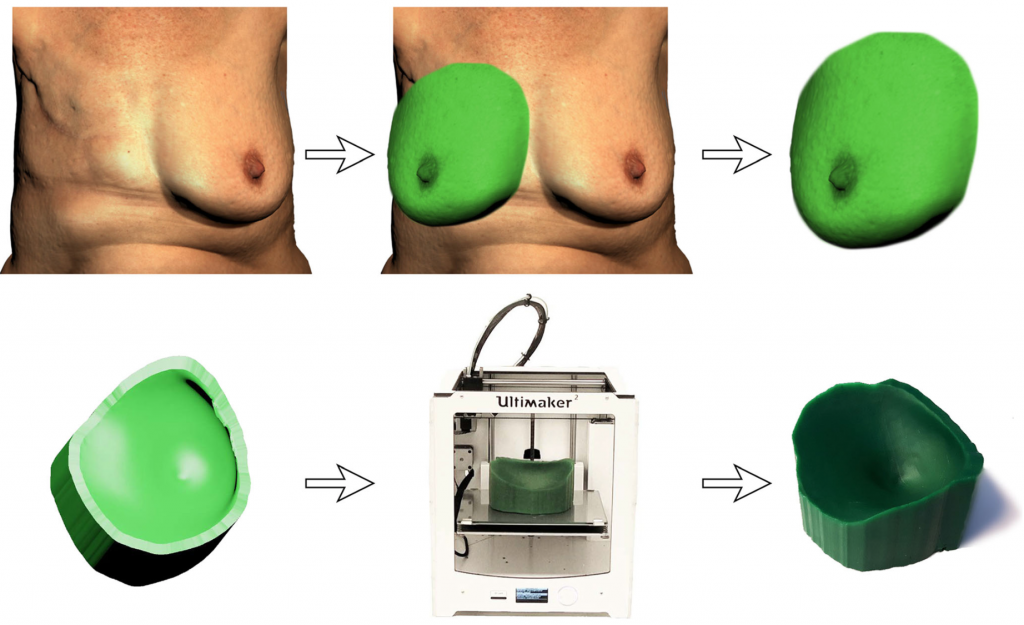Plastic surgeons at Radboud University in the Netherlands have demonstrated how 3D printing can be used to help reconstruct the breast tissue.
The findings, published in the European Journal of Plastic Surgery, discuss the applications and limitations of using patient-specific 3D prints as intraoperative guides.
Autologous reconstruction guides
The Radbound University study focuses on autologous “flap” reconstruction. In this procedure tissue from one part of the body, such as the abdomen or thigh, is used as material to rebuild another body part. It is a common practice for all types of breast correction surgeries, in cases of asymmetry and augmentation, and even following tumor removal.
As the researchers point out in this case, “Finesse and intuition are needed to harvest and establish the ideal flap shape and volume” of a breast. Therefore, “Providing aid in this process,” in the shape of a 3D printed guide, “can be beneficial for both surgeon and patient.”

Patient-specific 3D printing
Breast shape guides in the paper are automatically 3D modeled in Autodesk 3ds Max via 3D stereophotogrammetry.
As in photogrammetry, a stereophotogrammetic image is created from the stitching together of photographs around different angles of the breast. The “stereo” aspect of the technique means that points on each of the photographs are linked together to provide an accurate representation of the surface of the tissue.
Only one of the patient’s breasts is modeled for 3D printing, and so the guide is essentially a mirror image and negative impression of the remaining/desirable breast.

The results
In total, the Radbound University study used this method to model the breasts of 6 test patients. Each patient then underwent a procedure and surgeons used the 3D printed models to guide the shape of reconstruction.
Six to nine months after the operations, each patient had photos taken for assessment. The effect on each patient was different. Some patients experienced minimal differences in the symmetry of their breasts. For others, the difference was more pronounced. This was due in part to the unavailability of sufficient donor tissue, or a request for a reduction in the construction of the new breast.
Accordingly:
“For the template to be utilized to its full potential, patient selection for the creation of 3D printed breast molds is crucial.”
As the study concludes, “The most potential of this technique would lay in unilateral patients who are satisfied with the shape of their unaffected breast and have adequate donor site volume,”
“In bilateral reconstructions a symmetric breast reconstruction may be obtained more conveniently.”
3D printing uptake in healthcare
3D printed surgical guides have proven useful in a number of patient case studies around the world. In February 2018, a team at the University Hospital of Wales successfully completed a jaw reconstruction procedure using guides 3D printed by Renishaw. In July 2017, the British National Health Service (NHS) also appointed its first ever biomedical 3D technician for such purposes, evidence of the uptake of 3D printing in healthcare.
Next steps for the team at Radbound University include conducting a larger study to consider clinical outcomes such as “patient satisfaction, surgery time, breast volume, size and symmetry.”
Overall, at present, “According to surgeon’s opinion, 3D printed breast templates could be a useful tool during the operation for assessing the flap volume, shape, and orientation.”
“Applications and limitations of using patient-specific 3D printed molds in autologous breast reconstruction” is available open-access in the European Journal of Plastic Surgery. It is co-authored by Stefan Hummelink, Arico C. Verhulst, Thomas J. J. Maal and Dietmar J. O. Ulrich.
For more of the latest research sign up to the 3D Printing Industry newsletter, Also, follow us on Twitter, and like us on Facebook.
On the lookout for new talent or seeking a career change? Search and post 3D Printing Jobs for opportunities and new talent across engineering, marketing, sales and more.
Featured image shows a breast anatomy diagram. Image via Glasgow Uni Medicine ILOs



